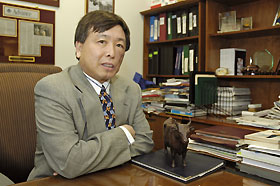Stem Cell Line From Cattle May Offer
Breakthrough Tool For
Scientists
 |
| Jerry Yang, a professor of animal science, has developed a line of bovine stem cells that may serve as a model for insight into cell-based therapies for humans. |
|
Photo by Dollie Harvey |
For the first time, researchers at UConn have generated a stable line of embryonic stem cells from cloned cattle embryos that can make unlimited copies of themselves and can morph into cells for nearly all bovine body tissues and organs.
The research may offer a breakthrough tool for scientists studying the use of such cells to treat disease, because it also suggests that cattle stem cell lines may serve as a better model than those from other species for insight into human cell-based therapies.
“The bovine stem cells we generated are different from all previously reported lines in both morphology and marker expression patterns,” says Xiangzhong (Jerry) Yang, a professor of animal science and director of the University’s Center for Regenerative Biology. “This is the first report demonstrating morphology similar to those of established stem cells in humans and mice.”
The researchers, led by Yang, include Cindy Tian, also with the Center for Regenerative Biology, and Enkui Duan of the Institute of Zoology of the Chinese Academy of Sciences in Beijing, China. They report their findings in the March 2005 issue of Biology of Reproduction.
Their results come as international research on embryonic stem cells is gathering speed. Because embryonic stem cells can self-renew and grow into virtually any cell in the body, they offer a potentially unlimited supply of specific cells for replacement therapy in degenerative disorders such as diabetes and Parkinson’s disease.
But for embryonic stem cell-based therapy to become a clinical reality, translational research involving nonhuman species is essential. Stable embryonic stem cell lines have been established in a few species, such as mice and monkeys, but generating a stable bovine embryonic stem line has proven difficult.
Results have varied in five reported attempts to generate bovine embryonic stem cell lines that are pluripotent – capable of proliferating indefinitely and differentiating into a wide variety of cell types. Also, none of these earlier studies of bovine embryonic stem cells found any cell surface markers of proteins required for growth that are normally associated with embryonic stem cell lines generated from other species.
Yang and his colleagues began their study by creating three separate bovine embryonic stem cell lines – one obtained from an in vitro fertilized embryo and two others from nuclear transfer embryos.
The in vitro technique involves a “test tube” embryo that is formed after an egg is fertilized in the laboratory. Nuclear transfer involves removing the nucleus from an unfertilized egg and replacing it with the DNA taken from a cell elsewhere. Using chemicals and electric shock, the egg containing the transferred DNA is then induced to divide until it forms a hollow, fluid-filled cavity surrounded by a layer of cells. This embryo, known as a blastocyst, holds the precursors to embryonic stem cells.
The researchers cultivated the three stem cell lines in the laboratory, growing them into large, multicellular colonies resembling mouse and human embryonic stem cells. Throughout this period they also studied the makeup of the cells, by washing the clusters with chemicals that prompted stains – or cell surface markers – associated with pluri-potency in embryonic stem cells.
“The fact that the embryonic stem cell-specific marker staining pattern is very similar to the human embryonic stem cells suggests that bovine embryonic stem cells may serve as a better model than mouse embryonic stem cells for human embryonic stem cell regeneration studies,” Yang says.
After sustaining continuous undifferentiated growth in the colonies for over a year, the researchers found that the cells maintained an ability to form globular clusters, called embryoid bodies, representative of the body’s three broad cell lines (endoderm, mesoderm, and ectoderm) both in vivo and in vitro. Yang says this indicates their ability to morph into cells for nearly all body tissues.
If researchers can find a way to direct the growth of embryonic stem cells in the lab, they may be able to engineer healthy cells to treat a range of ailments. This will require efficient methods to grow tissue-specific cells as the embryonic stem cells differentiate.
Using enzymes to break up colonies and isolate individual cells for new colony formation instigates this process in mouse, monkey, and human cell lines. In this study, researchers found that enzymes failed to break apart the bovine embryonic stem cell colonies and induce spontaneous differentiation.
“Previous studies have shown that the embryonic stem cells’ self-renewal pathway differs between species,” Yang says. “Further studies are needed to understand why bovine pluripotent embryonic stem cells are not amenable to enzymes.”

